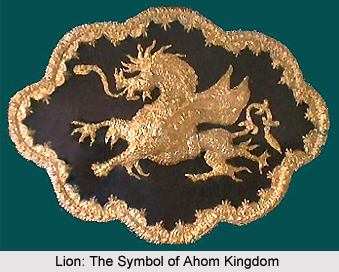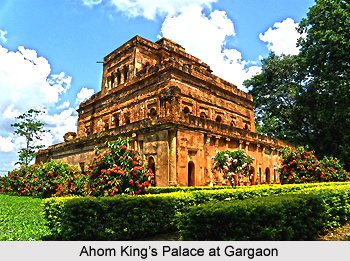 Ahom Rule refers to the medieval kingdom in the Brahmaputra River Basin and valley in Assam that maintained its sovereignty for nearly 600 years and successfully resisted Mughal Dynasty`s expansion in North-East India. The dynasty was established by Sukaphaa, a Shan prince of Mong Mao whose arrival in Assam after crossing the Patkai Mountains started the history. The rule of this dynasty wrecked with the Burmese invasion of Assam and the subsequent annexation by the British East India Company following the Treaty of Yandabo in 1826.
Ahom Rule refers to the medieval kingdom in the Brahmaputra River Basin and valley in Assam that maintained its sovereignty for nearly 600 years and successfully resisted Mughal Dynasty`s expansion in North-East India. The dynasty was established by Sukaphaa, a Shan prince of Mong Mao whose arrival in Assam after crossing the Patkai Mountains started the history. The rule of this dynasty wrecked with the Burmese invasion of Assam and the subsequent annexation by the British East India Company following the Treaty of Yandabo in 1826.
History of Ahom Rule
Chaolung Sukaphaa (reign 1228-1268), also Siu-Ka-Pha, the first Ahom king in medieval Assam, was the founder of the Ahom kingdom. The kingdom he established in 1228 existed for nearly six hundred years and in the process unified the various tribal and non-tribal peoples of the region that left a subterranean brunt on the region. In reverence to his position in history of Assam the honorific Chaolung is generally associated with his name.
The Ahom kings were believed to be of divine origin. According to Ahom tradition, Sukaphaa was a descendant of Khunlung, who had come down from the heavens and ruled Mong-Ri-Mong-Ram. During the reign of Suhungmung (1497-1539) which saw the composition of the first Assamese Buranji and increased Hindu influence, the Ahom kings were traced to the union of Lord Indra (identified with Lengdon) and Syama (a low-caste woman), and were declared Indravamsa kshatriyas, a lineage created for the Ahoms. Suhungmung adopted the title Swarganarayan, and the later kings were called Swargadeos (Lord of the heavens).
 Religion under Ahom Rule
Religion under Ahom Rule
Hindu influence first entered the Ahom court during the reign of King Sudangpha Bamuni- onwar (1397-1407), who had been brought up in a Brahmin family. The Hindu influence was more marked in the reign of King Pratap Singha who was personally grateful to Brahmin priests for ridding him of a demon which had possessed him during his prince hood. The first Ahom king to accept Hinduism formally was, however, Jayadhvaja Singha. Jayadhvaja Singha and his successors up to Lora Raja were initiated in Vaisnava faith. Gadadhar Singha persecuted the Vaisnavas, and bestowed royal patronage upon the Saktas and showed great honour and courtesy to Sakta priests. When his son, King Siva Singha, became a disciple of a Sakta Brahmin, the Saktas got into ascendancy. Credit must be given to the tribal friendly Ahom monarchy in diluting the caste system in Assam and removing untouchablity, in particular, to a great extent
Language, Literature during Ahom Rule
Mass education was absent in the Ahom kingdom. Even most of the nobles and kings were unschooled and were rather schooled in warfare and in administration. Perhaps the economy of the state did not permit opening schools for the masses or it might be the wish of the crown to keep the common subjects unschooled. However, the Ahom priest clans namely the Deodhais, the Bailungs and the Mohans continued their schooling in Ahom language, they also wrote Buranjis(history/royal diaries) in Ahom languge and Ahom language continued to be the court language almost to the end of the Ahom regime. The practice of writing Buranjis started from the days of the founder king Hso-Ka-Hpa. Hasti bidyarnav, a pictorial Hand-Book on elephant written in Assamese during the middle part of the Ahom regime is a master piece of its kind in the whole world. Another remarkable literary work of that time was Religious Epics during Ahom Rule like Ramayana to Assamese language by Madhab Kandali in the fourteenth century under patronage of the Barahi king, Mahamanikya.
Art and Culture during Ahom Rule
Even though the Royal house did not impose anything of their Tai culture and social customs on the subjects, yet all the good customs and culture flew into the Assamese culture thus a strong fabric of national cultural assimilation was woven. The Assamese musical instruments dhol (drum) was brought by the Ahoms from the Shan country, Maolung. Maihang, Bankahi, Banbati, Sharai, etc. the dishes and utensils used by the Ahoms became popular among other communities of Assam, as well. Assamese ornaments like Jangphai, Jonbiri, Gam Kharu etc. and dresses like Khingkhap, ahom Mekhela are all of Ahom origin. Muga silk worms were first reared by the Ahoms. The costumes prepared with Muga golden silk fabrics are still regarded as the dresses of national honour and dignity in Assam. The plain Janpis and floral Janpis used by the Ahoms became popular headgears for other tribes also.
Ahom People
The Tai Ahoms who came into Assam followed their traditional religion and spoke the Tai language. They were a very small group numerically and after the first generation, the group was a mixture of the Tai and the local population. Over time the Ahom state adopted the Assamese language and kings and other high officials converted to Hinduism. Except for some special offices (the king and the raj mantris), other positions are open to members of all tribes and religion. They kept good records, and are known for their chronicles, called Buranjis.
Downfall of Ahoms
Their power declined in latter half of the 18th century. The capital city was taken for a short period during the Moamoria rebellion. In the first part of the 19th century, the Burmese army invaded their kingdom that set up a puppet Ahom king. The Burmese were defeated by the British in the First Anglo-Burmese War resulting in the Treaty of Yandaboo in 1826, which paved the way for the British to convert the Ahom kingdom into a principality and which marked the end of the Ahom rule.
Ahom rule in Assam depicts the overall development of Assam from politics to literature to economy etc. The most distinctive aspects of the period, as noticed earlier, were the geographical and racial unification of the country, stabilisation of the political institutions, organisation of the economic, social and religious systems, and the rise of cultural nationalism.






